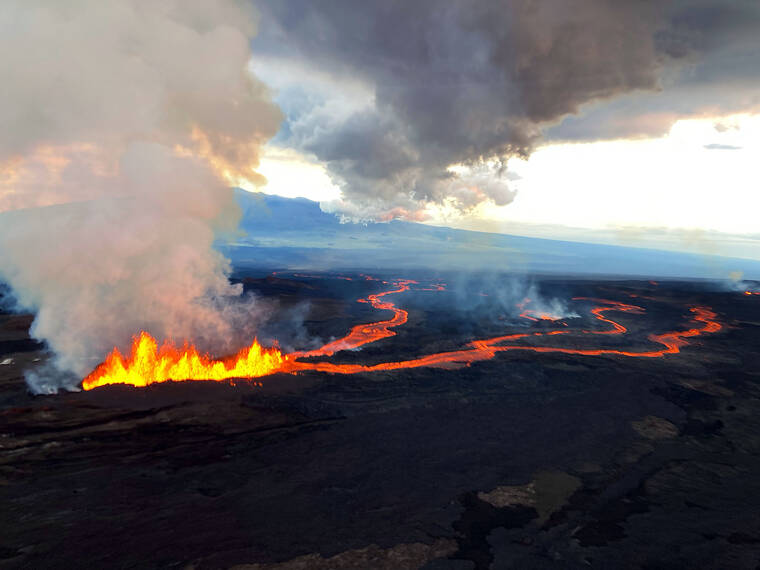At 10:45 p.m. Sunday evening, Nov. 27, USGS Hawaiian Volcano Observatory scientists were alerted to an earthquake swarm beneath Mauna Loa. Before an hour had gone by, lava had broken the surface within Moku‘aweoweo, the summit caldera, for the first time in 38 years.
For HVO and Island of Hawaii residents, this eruption did not come as a surprise. Increasing rates of earthquake activity and ground deformation on Mauna Loa began in late September, providing clues to the accumulating magma below the surface.
HVO has been working with the County of Hawaii Civil Defense Agency (HCCDA) to increase awareness of the potential for a Mauna Loa eruption through community meetings and other messaging. One important message at those meetings was that things could escalate very quickly, and they did.
HVO staff and County of Hawaii officials closely monitored the eruption overnight, tracking activity for any migration. The eruption had begun in Mauna Loa’s summit, as expected, and the question on everyone’s mind was whether the eruption would move into a rift zone and if so, which one.
Of the 33 Mauna Loa eruptions since 1843, all have started within Moku‘aweoweo. About half then migrated into one of the two rift zones or, rarely, a radial vent on the northwest flank. None of the eruptions have jumped from one rift zone to another.
Mauna Loa followed the pattern of previous eruptions when a vent opened high on the Northeast Rift Zone the morning of November 28, with three more opening over the next day. Lava flows began to travel north and northeast on the remote northeast flank. The summit vents ceased erupting.
The eruption has provided spectacular views from the Daniel K. Inouye Highway (Saddle Road) that bisects the Island of Hawaii; though it has also created heavy traffic in the area and is generating vog (volcanic air pollution) downwind.
There are many variables at play and both the direction and timing of flow advance will change over periods of hours to days. HVO and HCCD are working together closely to monitor the activity and keep Island of Hawaii residents and visitors informed.
As of now, no homes or property have been directly impacted or are in imminent danger due to the lava flow. Nonetheless, it is still a good idea to practice “All Hazards” readiness. Information on putting together an “All Hazards” plan for you and your family is available at this HCCDA website: https://www.hawaiicounty.gov/departments/civil-defense/emergency-preparedness.
For residents, visitors, and scientists alike, this eruption is an amazing opportunity to observe, document, and learn.
HVO staff have been busy tracking the dynamic fissures and lava flows, deploying new instruments to monitor the eruption, and analyzing samples of the eruption.
Erupted lavas have undergone a rapid analysis by HVO and our partners at the University of Hawaii at Hilo. Preliminary comparison of new lava chemistry with other Mauna Loa eruptions shows that the new lavas are not leftover from the 1984 eruption but represent a new intrusion of magma into the summit and Northeast Rift Zone, consistent with geophysical signals leading to the eruption.
What can we expect moving forward? Past Mauna Loa Northeast Rift Zone eruptions have typically lasted a few weeks; though, in one instance, a Northeast Rift Zone eruption continued for over a year. The main lava flow has slowed significantly and is currently in a flat portion of Humu‘ula Saddle region, making it difficult to estimate when or if the flow will impact Daniel K. Inouye Highway.
HVO will release updates twice a day in the morning and afternoon until activity changes, these can be accessed at https://www.usgs.gov/volcanoes/mauna-loa/volcano-updates. Up-to-date images and maps are also available from HVO’s website at https://www.usgs.gov/volcanoes/mauna-loa/multimedia. HCCDA will also be issuing updates until further notice at https://hawaii-county-volcano-hazards-hawaiicountygis.hub.arcgis.com/. We encourage residents and visitors to get information about this eruption from these trusted sources.
Volcano
activity updates
Mauna Loa is erupting. Its USGS Volcano Alert Level is at WARNING. Mauna Loa updates are issued daily.
Mauna Loa began erupting at approximately 11:30 p.m. HST on November 27. Eruptive activity started in Moku‘aweoweo caldera and migrated to the Northeast Rift Zone eruption hours later.
Fissure 3 remains the dominant source of the largest lava flow. For more information on current eruption of Mauna Loa, see: https://www.usgs.gov/volcanoes/mauna-loa/mauna-loa-eruption-webpage.
Kilauea is erupting. Its USGS Volcano Alert level is at WATCH. Kilauea updates are issued daily.
Over the past week, lava has continued to erupt from the western vent within Halema‘uma‘u crater in Hawaii Volcanoes National Park. Sulfur dioxide emission rates remain elevated and were last measured at approximately 316 tonnes per day (t/d) on November 23. Seismicity is elevated but stable, with few earthquakes and ongoing volcanic tremor. Over the past week, summit tiltmeters recorded several deflation-inflation (DI) events. For more information on the current eruption of Kilauea, see https://www.usgs.gov/volcanoes/kilauea/recent-eruption.
There were 8 events with 3 or more felt reports in the Hawaiian Islands during the past week: a M3.7 earthquake 3 km (2 mi) SSW of Pahala at 35 km (22 mi) depth on Nov. 30 at 10:02 p.m. HST, a M2.6 earthquake 31 km (19 mi) W of Volcano at -3 km (-2 mi) depth on Nov. 29 at 5:07 a.m. HST, M2.6 earthquake 9 km (5 mi) E of Pahala at 32 km (20 mi) depth on Nov. 29 at 3:42 a.m. HST, a M4.0 earthquake 9 km (5 mi) E of Pahala at 31 km (19 mi) depth on Nov. 29 at 3:26 a.m. HST, a M3.5 earthquake 21 km (13 mi) W of Volcano at 0 km (0 mi) depth on Nov. 28 at 8:59 p.m. HST, a M3.5 earthquake 30 km (18 mi) E of Honaunau-Napoopoo at -3 km (-1 mi) depth on Nov. 27 at 11:51 p.m. HST, a M3.5 earthquake 27 km (16 mi) E of Honaunau-Napoopoo at -2 km (-1 mi) depth on Nov. 27 at 11:12 a.m. HST, and a M4.2 earthquake 27 km (16 mi) E of Honaunau-Napoopoo at -1 km (0 mi) depth on Nov. 27 at 10:56 p.m. HST.
HVO continues to closely monitor the ongoing eruptions at Kilauea and Mauna Loa.
Please visit HVO’s website for past Volcano Watch articles, Kilauea and Mauna Loa updates, volcano photos, maps, recent earthquake info, and more. Email questions to askHVO@usgs.gov.
Volcano Watch is a weekly article and activity update written by U.S. Geological Survey Hawaiian Volcano Observatory scientists and affiliates.






